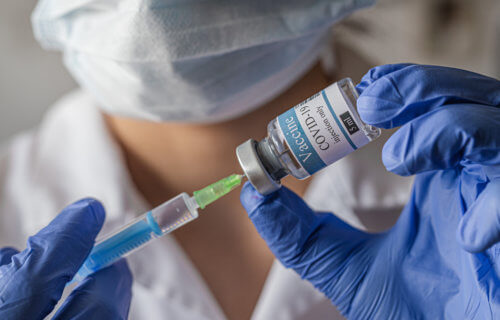ST. LOUIS — We have all seen images of the microscopic coronavirus particle with its trademark spiky crown. Those protrusions are proteins that enable the virus to attach to human cells, making the disabling of them the primary focus of most vaccine development. Scientists with Washington University School of Medicine are using the same process that created the Ebola vaccine to develop an experimental coronavirus vaccine.
Researchers in St. Louis caution this potential vaccine, made from a genetically modified virus, is still in its earliest stages of testing. Thus far, however, it’s preventing pneumonia in mice while producing high levels of antibodies.
“Unlike many of the other vaccines under development, this vaccine is made from a virus that is capable of spreading in a limited fashion inside the human body, which means it is likely to generate a strong immune response,” says study co-author Dr. Michael S. Diamond in a university release.
Using a virus to beat the pandemic
To create the hybrid vaccine for novel coronavirus, researchers are following the same concepts of Ebola vaccine testing. That treatment has been safely administered to thousands in Africa, North America, and Europe. The idea is to start with a livestock virus that causes only mild, flu-like illness in humans. Then, scientists switch out one gene to provoke an immune response to a second disease.
Having the spike gene from coronavirus included in a harmless virus gives the body a chance to develop protective antibodies against these proteins. The antibodies are then available to fight any future exposure to the COVID-19 virus.
During the current research, scientists swap one gene of the vesicular stomatitis virus (VSV) for the spike gene of SARS-CoV-2 — the virus strain causing COVID-19. The team calls this virus is VSV-SARS-CoV-2.
Researchers used mice to test the efficacy of the vaccine. Since they are not naturally susceptible to COVID-19 however, the scientists are artificially enhancing their susceptibility or using genetically modified mice.
Neutralizing pneumonia
The mice were split into two major groups. Group One received a dose of VSV-SARS-CoV-2. Group Two was given a booster dose of the vaccine four weeks after the first inoculations. A third group, serving as the control group, was given a placebo.
Three weeks after each injection, blood was drawn from the mice to test for SARS-CoV-2 antibodies. The report finds high levels of neutralizing antibodies in Group One after just one dose of the vaccine. Group Two, which received a second dose of the vaccine, showed 90-fold increase in antibodies over Group One.
So how would this vaccine stand up over time? Researchers waited five weeks after the final dose of vaccine had been administered before testing the mice for antibody strength again. After spraying COVID-19 into their noses, the results show the vaccine provides complete protection against pneumonia.
For mice in Groups One and Two, there are also no infectious virus particles in the lungs four days after an infection.
On the other hand, the control mice in Group Three have elevated levels of virus in their lungs. Researchers also note that the lungs of vaccinated mice displayed fewer signs of damage and inflammation than unvaccinated subjects.
Potential coronavirus vaccine ‘very promising’
With six vaccines already in the final stages of human testing, the research team accepts that this experimental vaccine will not be among the first out of the gate. Despite the delay, it may offer a potentially safer, less expensive alternative to first-generation vaccines.
“Since the virus is capable of replicating, it can be grown to high levels in the lab, so it’s easy to scale up and should be more cost-effective than some of the other vaccine candidates,” Diamond says. “So while what we have shown is just the proof of concept, I think it’s very promising. Our vaccine candidate is now being tested in additional animal models with the goal of getting it into clinical trials as soon as possible.”
Results of the study are published in the journal Cell Host and Microbe.
